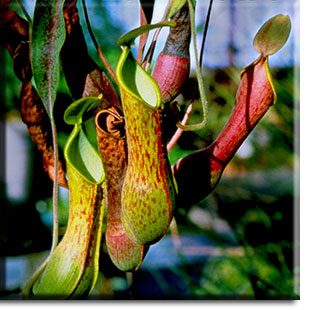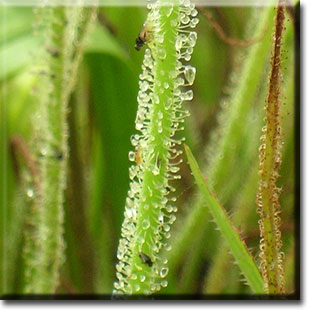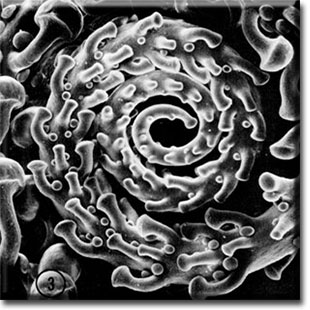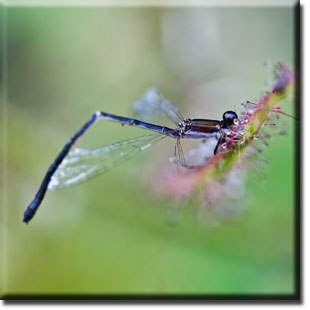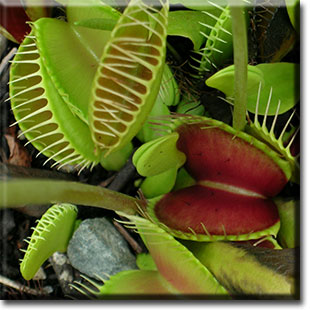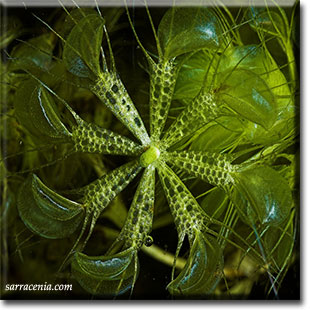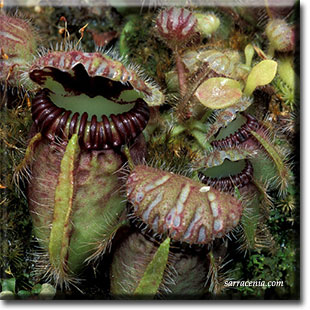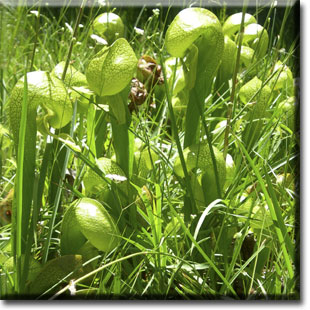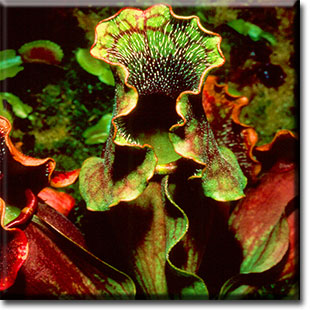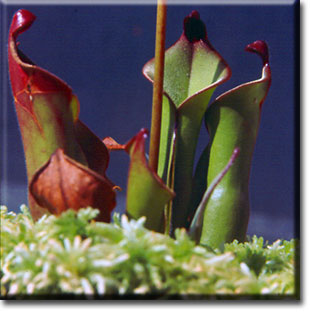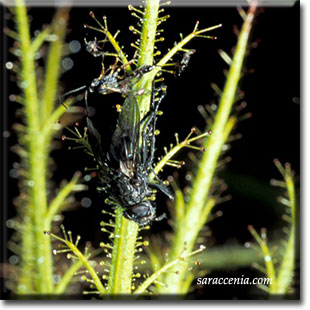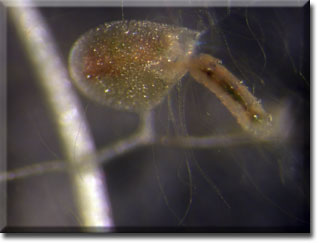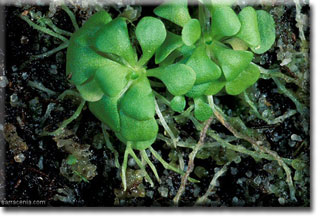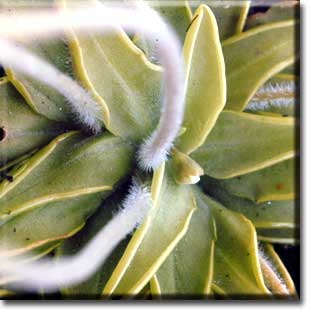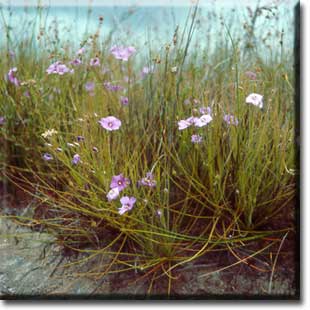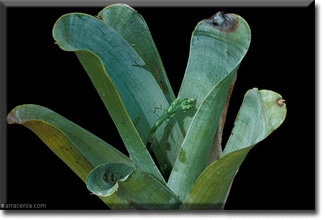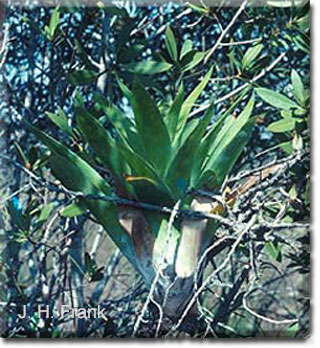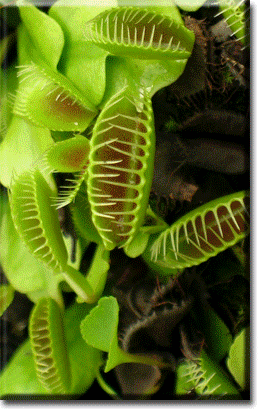
The Botanical Society of America is pleased to provide the "Carnivorous Plant" pages. We are in the early stages of developing this section of our site; check back regularly. In the meantime, enjoy the images (mainly donated by members) and the stories they tell. We hope these strange and interesting plants open up your possibilities for asking new questions about the fascinating lives of plants!
Carnivorous plants have the most bizarre adaptations to low-nutrient environments. These plants obtain some nutrients by trapping and digesting various invertebrates, and occasionally even small frogs and mammals. Because insects are one of the most common prey items for most carnivorous plants, they are sometimes called insectivorous plants. It is not surprising that the most common habitat for these plants is in bogs and fens, where nutrient concentrations are low but water and sunshine seasonally abundant. As many as thirteen species of carnivorous plants have been found in a single bog (Folkerts, 1982). Most plants absorb nitrogen from the soil through their roots. But carnivorous plants absorb nitrogen from their animal prey through their leaves specially modified as traps.
Traps work in a variety of ways.
Pitfall traps of pitcher plants are leaves folded into deep, slippery pools filled with digestive enzymes.
Flypaper (or sticky or adhesive traps) of sundews and butterworts are leaves covered in stalked glands that exude sticky mucilage.
Snap traps (or steel traps) of the Venus flytrap and waterwheel plant are hinged leaves that snap shut when trigger hairs are touched.
Suction traps, unique to bladderworts, are highly modified leaves in the shape of a bladder with a hinged door lined with trigger hairs.
Lobster-pot traps of corkscrew plants are twisted tubular channels lined with hairs and glands.
Carnivorous plants are fascinating because, even when they are not trapping insects, their unusual forms are intriguing. However, you should not collect plants in the wild because most of them are relatively rare. Habitat destruction and over collection are two of the greatest conservation threats to carnivorous plants. If you are interested in growing carnivorous plants in your home or classroom, purchase the plants from a reputable grower who uses tissue culture or vegetative means to grow the plant, or starts them from seeds.
Unraveling the story of carnivorous plant evolution and ecology has occupied biologists for centuries. Charles Darwin's extensive experiments confirmed the carnivorous habit for several genera. Carnivory has been documented in at least 9 plant families and 600 species.
We now know that the carnivorous habit evolved independently in many plant lineages (Albert et al., 1992; Ellison and Gotelli, 2001; Cameron et al., 2002; Muller et al., 2004). Pitfall traps evolved independently in four plant groups (the eudicot orders Caryophyllales, Oxalidales, Ericales, and the monocot family Bromeliaceae), and sticky traps, in at least three (the Caryophyllales, Ericales, and Lamiales). These are examples of convergent evolution. In contrast, the snap trap and lobster-pot traps evolved only once among carnivorous plants. In the descriptions below, the plant groups and names follow the Angiosperm Phylogeny Group II (1993) and Peter Stevens' Angiosperm Phylogeny Website, which do not use formal classification ranks above the level of the order.
Kingdom: Plantae — Eudicots, Basal Eudicots
Order: Caryophyllales
|
|
|
|
|
Family: Nepenthaceae
|
|
Family: Drosophyllaceae
One species occupying coastal habitats in northern Morocco, Portugal, and southwest Spain.
For more Drosophyllum information - CLICK HERE
|
|
|
|
|
|
|
|
|
Family: Dioncophyllaceae
Genus: Triphyophyllum
One species occupying rainforest habitats in West Africa (Liberia, Sierra Leone, and Ivory Coast).
More Triphyophyllum peltatum information COMING SOON!
|
|
Family: Droseraceae
Genus: Drosera Sundew
Currently 152 listed species occupying temperate and tropical habitats throughout the world.
For more Drosera information and images - CLICK HERE
|
|
|
|
|
|
|
|
|
Family: Droseraceae
Genus: Dionaea Venus Flytrap
One species occupying habitats in the southeastern United States of America (North Carolina, South Carolina).
For more Dionea muscipula information and images - CLICK HERE
|
|
Family: Droseraceae
Genus: Aldrovanda Waterwheel Plant
One species occupying aquatic habitats in Europe, Asia, and Australia. Once widely distributed in Africa, India, and Japan.
More Aldrovanda vesiculosa information COMING SOON!
|
Kingdom: Plantae — Eudicots, Rosids, Eurosids I
Order: Oxalidales
Kingdom: Plantae — Eudicots, Asterids, Basal Asterids
Order: Ericales
|
|
|
|
|
Family: Sarraceniaceae
Genus: Darlingtonia Cobra Lily
One species occupying boggy habitats in the northwest United States of America (southern Oregon, northern California).
For more Darlingtonia californica information CLICK HERE
|
|
Family: Sarraceniaceae
Genus: Sarracenia Pitcher Plant
Currently 10 listed species occupying habitats in eastern North America (central Canada to southeastern United States of America).
For more Sarracenia information - CLICK HERE
|
|
|
|
|
|
|
|
|
Family: Sarraceniaceae
|
|
Family: Roridulaceae
Genus: Roridula Bug Plant or South African Fly Bush
Two species occuring in fynbos of Southern Africa. Roridula has sticky leaves to trap insects but lacks enzymes to digest them. It has sometimes been considered as carnivorous, sometimes not. Evaluate the evidence and decide for yourself.
More Roridula information and images COMING SOON!
|
Kingdom: Plantae — Eudicots, Asterids, Euasterids I
Order: Lamiales
|
|
|
|
|
Family: Lentibulariaceae
Genus: Utricularia Bladderwort
Currently 220 listed species occupying temperate and tropical habitats throughout the world--the most diverse and widespread genus of carnivorous plants.
For more Utricularia information and images - CLICK HERE
|
|
Family: Lentibulariaceae
|
|
|
|
|
|
|
|
|
Family: Lentibulariaceae
|
|
Family: Byblidaceae
|
Kingdom: Plantae — Monocotyledons, Commelinids
Order: Poales, Family: Bromeliaceae
|
|
|
|
|
Subfamily Pitcairnioideae
Genus: Brocchinia
Of the 5 species in the genus occupying lowland savanna and mountain habitats in South America, at least 2 species are carnivorous.
More Brocchinia reducta and B. hectioides information COMING SOON!
|
|
Subfamily Tillandsioideae
Genus: Catopsis
Of the 21 species in the genus, 1 species is carnivorous. It occupies humid habitats in South America, Central America, Mexico, the West Indies, and Florida, U.S.A.
More Catposis berteroniana information COMING SOON!
|
Protocarnivorous Plants and Predatory Fungi
Carnivorous plants have features to attract, trap, kill, and digest prey, and absorb nutrients. A number of plants have only some of these characteristics. Glands that secrete sticky substances are found in many plants. Pitcher-like tanks are common in bromeliads and in few other plants. While perhaps not fully fledged sticky traps or pitfall traps, these features hint of the potential for carnivory. The list of plants described as near carnivorous, protocarnivorous, or borderline carnivorous is quite diverse, including Ibicella lutea (Mameli, 1916), Dipsacus (Christy, 1923), Passiflora foetida (Radhamani et al., 1995), Paepalanthus bromeloides (Jolivet, 1998), and Geranium viscosissimum and Potentilla arguta (Spomer, 1999). No single definitive list exists. Ibicella lutea, which has not been studied since 1916 (Juniper et al., 1989), is sometimes listed as carnivorous, and Catopsis berteroniana is sometimes described as borderline. The ability to digest prey and absorb the amino acids is considered the real clincher.
Carnivory is more widespread than just the plant and animal kingdoms. The fungi kingdom has flesh eaters also (Pramer, 1964). Living in the soil are over 200 species of fungi (identified as zygomycetes, basidiomycetes, and hyphomycetes) that use special structures to trap nematodes. Like carnivorous plants, these fungi have the ability to trap prey and to absorb nutrients from the body of their prey. The traps of fungi come in two general types: constricting rings (active traps) and adhesive structures (passive traps). These trap types occur in separate fungi lineages (Ahren et al., 1998).
Special thanks to Dr. Sherwin Carlquist, Dr. Janice Glime, Dr. David Webb, Dr. Barry Rice (www.sarracenia.com), Dr. J. Howard Frank and the International Carnivorous Plant Society for their contributions to these pages!
References
Ahrén, D., Bjõrn, M. U., and Tunlind, A. 1998. Phylogeny of nematode-trapping fungi based on 18S rDNA sequences. FEMS Microbiology Letters 158: 179--184.
Albert, V.A., S.E. Williams, and M.W. Chase. 1992. Carnivorous plants: phylogeny and structural evolution. Science 257: 1491--14955.
Angiosperm Phylogeny Group. 2003. An update of the Angiosperm Phylogeny Group classification for the orders and families of flowering plants: APG II. Botanical Journal of the Linnean Society 141: 399--436.
Cameron, K.M., Wurdack, K.J., and Jobson, R.W. 2002. Molecular evidence for the common origin of snap-traps among carnivorous plants. American Journal of Botany 89:1503--1509.
Christy, M. 1923. The common teasel as a carnivorous plant. Journal of Botany 61: 33--45.
Ellison, A.M. and Gotelli, N.J. 2001. Evolutionary ecology of carnivorous plants. Trends in Ecology and Evolution 16:623--629.
Folkerts, G. W. 1982. The gulf coast pitcher plant bogs. American Scientist 70: 260--267.
Jolivet, P. 1998. Interrelationships between insects and plants. CRC Press, Boca Raton.
Juniper, B.E., Robins, R.J., and Joel, D.M. 1989. The Carnivorous Plants. Academic Press, London.
Mameli, E. 1916. Ricerche anatomiche, fisiologiche e biologiche sulla Martynia lutea Lindl. Atti dell'Universita di Pavia, Serie 2, 16, 137--188.
Müller, K., Borsch, T., Legendre, L., Porembski, S., Theisen, I., and Barthlott, W. 2004. Evolution of carnivory in Lentibulariaceae and the Lamiales. Plant Biology 6: 477-490.
Pramer, D. 1964. Nematode-trapping fungi. Science 144: 902--908.
Radhamani, T.R., Sudarshana, L., and Krishnan, R. 1995. Defence and carnivory: dual roles of bracts in Passiflora foetida. Journal of Biosciences 20: 657--664.
Spomer, G.G. 1999. Evidence of protocarnivorous capabilities in Geranium viscosissimum and Potentilla arguata and other sticky plants. International Journal of Plant Science 160:98--101.
Stevens, P. (2001 onwards) Angiosperm Phylogeny Website. Version 6, May 2005 [and more or less continuously updated since].
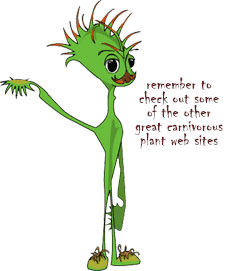
Intrigued? Want to see more? Take a look at the following pages!
Investigate the American Journal of Botany images & cover stories online: BSA Online Image Collection
Want to surf the web for more carnivorous plant information? —Try these sites:

International Carnivorous Plant Society
www.sarracenia.com
Tom's Carnivores - How to Grow Pitcher Plants - Interactive Sarracenia map
Tom's Carnivores - The Nepenthes Calculator
Tom's Carnivores - Where do Venus Flytraps come from?

